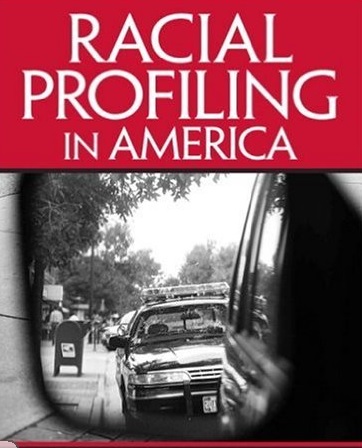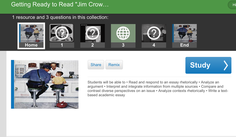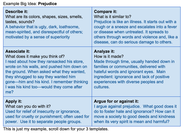3. RACIAL PROFILING:
Start with this Video
|
|
| ||||||
|
In addition to the focus on Common Core State Standards, the module targets these skill areas:
• Read and respond to an essay rhetorically • Analyze an argument • Interpret and integrate information from multiple sources • Compare and contrast diverse perspectives on an issue • Analyze contexts rhetorically • Write a text-based academic essay This module purposely focuses on a single essay, rather than on multiple essays on this issue, to provoke students to take a stand on this topic and produce their own claims for their final writing assignment. Until recently, Bob Herbert, the author of the essay in this module, was an Op-Ed columnist for the New York Times. He has also been a national correspondent for NBC and a reporter on the Today Show and NBC Nightly News. He presents his strong opinions on the subject of racial profiling and its negative effects on our culture, and students are asked to analyze and respond to his main claims in this essay. The module takes about two to three weeks to complete, depending on the background knowledge of the students.
|
AcT 1: Getting Ready to REad |
Act 2: Exploring Big Ideas |
SUPPLEMENTAL Podcasts
Writing Task: Pick a Controversial Topic
|
Write an essay that presents your opinion on a controversial issue of your choice. Begin with a debatable thesis statement. Then follow the guidelines for writing an argument essay. As you write your essay, be sure you support your claims with well-chosen evidence. If something in the media (such as a newspaper article, ad, or speech) inspired this assignment, attach a copy to your paper before you turn it in. Take the following steps for this exercise: • Read the assignment carefully. • Decide which issue you are going to discuss. • Discuss the purpose of the assignment (what will you try to accomplish in writing your essay?).
|

Need to find a topic? Check these databases
Ebsco Host (login: tvhs PW: research) SIRS (login: CA5583 PW:92592) GALE (login: tvhs PW: research) |
Considering Structure
Using "Jim Crow Policing" as a mentor text, let's consider the structure Bob Herbert used to make his point that New York City policing needs to stop racial profiling. Compare his text with the structure below, then use this structure to help you write your essay.
The number of paragraphs in an essay depends on the nature and complexity of the argument.
Introduction
• A “hook” to get the reader’s attention
• Background information the audience may need
• A thesis statement along with some indication of how the essay will be developed (“forecasting”).
Note: The thesis statement states the topic of the essay and the writer’s position on that topic. You may choose to sharpen or narrow your thesis at this point.
Body
The body of an essay should consist of the following parts:
• Paragraphs that present support for the thesis statement, usually in topic sentences supported with evidence. (Refer to “Getting Ready to Write.”)
• Paragraphs that include different points of view or address counterarguments
• Paragraphs or sentences in which you address those points of view by doing the following:
- Refuting them
- Acknowledging them but showing how your argument is better
- Granting them altogether but showing they are irrelevant
• Evidence that you have considered the values, beliefs, and assumptions of the audience; your own values, beliefs, and assumptions; and some common ground that appeals to the various points of view
Conclusion
The final paragraph (or paragraphs) should consider the following:
• A review of the argument that supports your thesis
• The significance of the argument—the “so what?” factor
The number of paragraphs in an essay depends on the nature and complexity of the argument.
Introduction
• A “hook” to get the reader’s attention
• Background information the audience may need
• A thesis statement along with some indication of how the essay will be developed (“forecasting”).
Note: The thesis statement states the topic of the essay and the writer’s position on that topic. You may choose to sharpen or narrow your thesis at this point.
Body
The body of an essay should consist of the following parts:
• Paragraphs that present support for the thesis statement, usually in topic sentences supported with evidence. (Refer to “Getting Ready to Write.”)
• Paragraphs that include different points of view or address counterarguments
• Paragraphs or sentences in which you address those points of view by doing the following:
- Refuting them
- Acknowledging them but showing how your argument is better
- Granting them altogether but showing they are irrelevant
• Evidence that you have considered the values, beliefs, and assumptions of the audience; your own values, beliefs, and assumptions; and some common ground that appeals to the various points of view
Conclusion
The final paragraph (or paragraphs) should consider the following:
• A review of the argument that supports your thesis
• The significance of the argument—the “so what?” factor
Citing Sources

As students choose and research their topics, they should be learning. Any learning that takes place means student got an idea from somewhere else. If students indicate where the idea came from, that's called "citing your sources" and people applaud you for doing research. If students don't indicate where the idea came from, even just once, that's called "plagiarism" and you get kicked out of college... Seriously. It's a big deal. Study this Gooru collection to make sure you know the difference between the two and how to cite your sources correctly.






